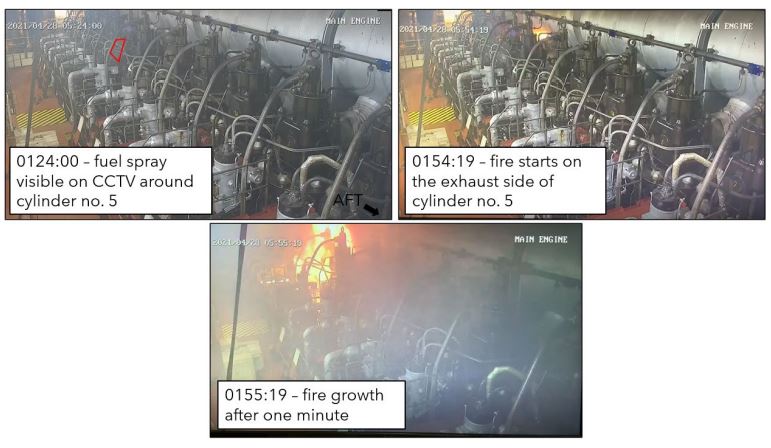An incorrectly installed section of main engine fuel oil return tubing led to an engine room fire aboard a containership off the coast of Santa Barbara, California, the National Transportation Safety Board said Tuesday.
The Incident
The fire aboard the M/V President Eisenhower broke out April 28, 2021 as the ship transited through the Santa Barbara Channel on a voyage to Oakland, California with a crew of 22.
The crew extinguished the fire using the engine room’s fixed carbon dioxide fire-extinguishing system. As a result of the fire, the vessel lost propulsion and drifted for several hours before being towed to the Port of Los Angeles. No pollution or injuries were reported, but damage to the vessel totaled an estimated $8.22 million.
Investigation
A crewmember on watch noticed smoke coming from an open engine room hatch early in the morning on April 28. Two crewmembers donned firefighter outfits and attempted to use portable fire extinguishers to quell the fire. Realizing the fire was “too much,” the captain decided to release carbon dioxide into the engine room.
The day before the vessel’s departure, the second engineer installed a new section of steel fuel oil return tubing for the main engine. A post fire examination showed that a compression fitting on the end of the newly installed section of fuel return tubing had disconnected, causing the ultra-low sulfur diesel fuel oil the engine was burning to spray. CCTV footage from the vessel showed diesel oil spray about 30 minutes before the fire started. Within one minute after the fire started, cardboard and wooden boxes of spare parts, which were stored one deck above the main engine and next to the auxiliary boiler, caught on fire.

Investigators found that an unshielded and uninsulated exhaust valve compensator flange acted as an ignition source for the spraying diesel fuel. An examination of the disconnected fuel oil return tubing and failed compression fitting revealed that the compression fitting’s sealing ferrule was not sufficiently swaged to the steel tubing.
The NTSB determined the probable cause of the engine room fire was a crewmember insufficiently swaging a compression fitting ferrule during the installation of fuel oil return tubing for a main engine’s cylinder, allowing an end of the tubing to disconnect and spray fuel oil onto a nearby unshielded and uninsulated cylinder exhaust component.
Lessons learnt
NTSB further identified two lessons learned from this investigation:
- Rapid oil leak detection systems are a valuable tool that can be used to prevent fire in machinery spaces. Video analytic technology is designed to use standard CCTV video to detect fuel mist and spray in real time and alert the crew before any ignition and fire.
- The crew of the President Eisenhower effectively contained the spread of a main engine room fire by removing fuel and oxygen sources, cooling boundaries, and communicating effectively. This shows the importance of realistic scenario-based training, including engine room emergencies, which involve shutting down machinery, fuel oil, lube oil, and ventilation systems, as well as boundary monitoring, to quickly contain and suppress engine room fires, which can spread to other spaces and/or cause a loss of propulsion and electrical power.
Marine Investigation Report 22/15 can be found on the NTSB website.
Did you subscribe to our daily Newsletter?
It’s Free! Click here to Subscribe
Source: NTSB

















